

Jared Diamond. Jared Diamond (2007) Jared Mason Diamond (* 10.

September 1937 in Boston, Massachusetts) ist ein US-amerikanischer Evolutionsbiologe, Physiologe und Biogeograf. Leben[Bearbeiten] 1985 war er MacArthur Fellow. Werk[Bearbeiten] Das Hauptmotiv für seine anthropologischen und historischen Arbeiten sieht Diamond darin, nicht-rassistische Erklärungen für wesentliche Merkmale der menschlichen Geschichte zu finden. In Der dritte Schimpanse greift er auf Erkenntnisse der Evolutionsbiologie, Linguistik, Geschichte, Archäologie und weiterer Disziplinen zurück, um die Frage zu beantworten, wie die entscheidenden Besonderheiten der Menschen zu erklären sind: Lebenszyklus und Sexualverhalten, Sprache, Kunst, Landwirtschaft, Völkermord und Umweltzerstörung.
Für sein Buch Arm und Reich, in dem er drastische Unterschiede in der naturräumlichen Ausstattung der Kontinente als Faktoren für die weltweite Dominanz westlicher und asiatischer (d. h. In seinem Werk Warum macht Sex Spaß? Kritik[Bearbeiten] Interviews. Kollaps (Buch) Kollaps: Warum Gesellschaften überleben oder untergehen ist ein im Jahr 2005 erschienenes Buch des US-amerikanischen Geografieprofessors Jared M.
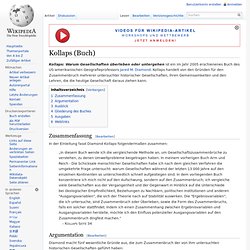
Diamond. Kollaps handelt von den Gründen für den Zusammenbruch mehrerer untersuchter historischer Gesellschaften, ihren Gemeinsamkeiten und den Lehren, die die heutige Gesellschaft daraus ziehen kann. Why societies collapse › Science Features (ABC Science) In Depth › Science Features Throughout human history societies have prospered and collapsed leaving behind tantalizing glimpses of their magnificence in crumbling temples, ruins and statues.

Why did these ancient civilisations fall apart? Why did some collapse and not others? And what lessons do they have for our civilisation? The New York Times > Opinion > Op-Ed Contributor: The Ends of the World as We Know Them. Published: January 1, 2005 os Angeles — NEW Year's weekend traditionally is a time for us to reflect, and to make resolutions based on our reflections.
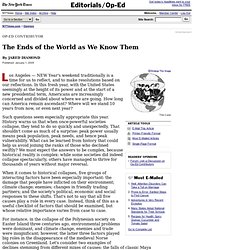
In this fresh year, with the United States seemingly at the height of its power and at the start of a new presidential term, Americans are increasingly concerned and divided about where we are going. How long can America remain ascendant? Where will we stand 10 years from now, or even next year? Such questions seem especially appropriate this year. Jared Diamond im Interview: Das Risiko heißt: Zusammenbruch der Weltgesellschaft - Erde. © F.A.Z.

-Helmut Fricke „Denken Sie nicht an Spenden”: Jared Diamond Überschwemmungen, Wirbelstürme, gewaltige Waldbrände, Raubrodungen, Luft- und Wasserverschmutzung: Die globale Dimension von Umweltverschmutzung und Klimaveränderung ist noch nie für jedermann so sichtbar geworden wie in den vergangenen Jahren. Wie werden die Gesellschaften des Westens und der aufstrebenden Industrienationen des Fernen Ostens darauf reagieren? Welche Wahl hat man? Der Biologe und Geograph Jared Diamond hat diese Frage in seinem jüngsten Werk „Kollaps“ (auf deutsch im S. Mehr zum Thema Das Werk, das im letzten Jahr in den Vereinigten Staaten veröffentlicht wurde, hat gleich bei Erscheinen großes Aufsehen erregt: Die Mahnung an die Vereinigten Staaten war unüberhörbar. Im vergangenen Jahr ist in den Vereinigten Staaten Ihr Buch „Kollaps. Sie hat mich erstaunt.
Bisher hat sich Amerika selbst noch nie als vom Untergang gefährdet gesehen? Living Through the Donner Party. Experience has taught us that the youngest and oldest people are the most vulnerable even under normal conditions, and their vulnerability increases under stress.
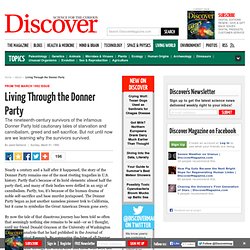
In many natural disasters, those under 10 or over 50 suffered the highest mortality. For instance, children under 10 accounted for over half the 240,000 deaths in the 1970 Bangladesh cyclone, though they constituted only one-third of the exposed population. Much of the vulnerability of the old and young under stress is simply a matter of insufficient physical strength: these people are less able to walk out through deep snow (in the case of the Donner Party) or to cling to trees above the height of flood waters (in the case of the Bangladesh cyclone).
Babies have special problems. Per pound of body weight a baby has twice an adult’s surface area, which means double the area across which body heat can escape. Forschung: Die jüngsten 13.000 Jahre. Der Universalgelehrte Jared Diamond hat die menschliche Galle erforscht, die Vogelwelt von Papua-Neuguinea – und die großen Linien der Geschichte.
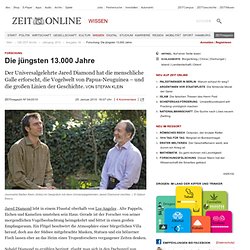
ZEITmagazin Nº 04/201025. Januar 2010 16:07 Uhr 6 Kommentare Speichern Drucken Twitter. Review: The World Until Yesterday: What Can We Learn from Traditional Societies? - Reviews - Books. Drawing on his own fieldwork from nearly five decades working and living in New Guinea, as well as evidence from the Inuits, Amazonian Indians, Aboriginal Australians and others, Diamond combines technical expertise with personal observations to offer a perceptive exposition of our recent past.

"All human societies have been traditional for far longer than any society has been modern," says Diamond. Rezension : Ein "Selbsthilfe-Handbuch" für "moderne" Menschen - Nachrichten Debatte - Kommentare. Dieses Buch sollte mir eigentlich gefallen.

Schließlich argumentiere ich seit Jahrzehnten, dass wir von indigenen Völkern lernen können. Diese Botschaft ist angeblich auch das Kernstück von Jared Diamonds neuem populärwissenschaftlichen Werk. Aber ist sie das wirklich? Seit fünfzig Jahren pendelt Diamond zwischen den USA und Neuguinea, um Vögel zu studieren. Die Insel und ihre Bevölkerung kennt er sicherlich gut. The World Until Yesterday by Jared Diamond – review. Computer simulations suggest war drove the rise of civilizations. According to British historian Arnold Toynbee, “History is just one damned thing after another.”
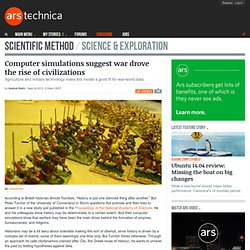
But Peter Turchin of the University of Connecticut in Storrs questions this premise and then tries to answer it in a new study just published in the Proceedings of the National Academy of Sciences. He and his colleagues show history may be deterministic to a certain extent. And their computer simulations show that warfare may have been the main driver behind the formation of empires, bureaucracies, and religions. Historians may be a bit leery about scientists making this sort of attempt, since history is driven by a complex set of events, some of them seemingly one-time only. But Turchin thinks otherwise. Guns, germs, and Steel: the fates of human societies. Guns, Germs, and Steel, my best-known book, was published in 1997. It has been translated into 36 languages, including all the major languages of book publishing, as well as languages of small markets such as Estonian and Serbian. It won the 1998 Pulitzer Prize for General Non-fiction, plus numerous other prizes.
'Guns, Germs, and Steel' Reconsidered. Real History versus Guns Germs and Steel - Anthropology 2.5. In 1997, ten years after calling agriculture The Worst Mistake in the History of the Human Race, Jared Diamond came out with Guns, Germs, and Steel , a landmark book that would win the Pulitzer Prize, become a best-seller, and be filmed by National Geographic for PBS. It is surely the most widely read book about agriculture anyone has ever written. 204.193.8.79/Social Sciences/Wasserman/World History/WH PDFs/CRITICAL RESPONSES TO Jared Diamond.pdf.